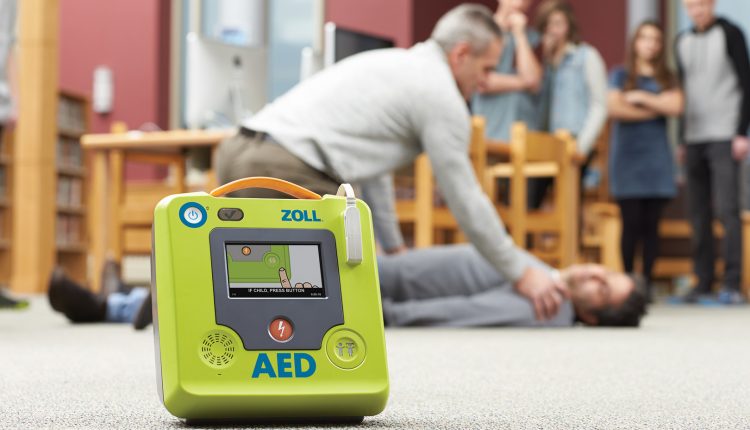
AED ແມ່ນຫຍັງແລະບ່ອນໃດທີ່ຈະຊອກຫາມັນ: ຂໍ້ມູນບາງຢ່າງສໍາລັບພົນລະເມືອງ
AED ແມ່ນສ່ວນຫນຶ່ງທີ່ສໍາຄັນຂອງລະບົບຕ່ອງໂສ້ການຢູ່ລອດ, ຍ້ອນວ່າມັນສາມາດຟື້ນຟູຈັງຫວະຫົວໃຈປົກກະຕິໃນຜູ້ເຄາະຮ້າຍຈາກການຈັບກຸມຫົວໃຈກະທັນຫັນ.
AED ແມ່ນຫຍັງ?
An automatic external defibrillator (AED) is a portable life-saving device designed to treat people suffering cardiac arrest.
Cardiac arrest is a condition in which the heart suddenly (and unexpectedly) stops beating.
The AED system includes all the necessary accessories, such as electrode pads and batteries, to be able to detect and interpret an electrocardiogram.
After applying the electrode pads to the bare chest of a person who has lost consciousness, is unresponsive and is not breathing normally, the device automatically detects whether an electric shock is needed to restore the normal rhythm of the heart.
Roughly speaking, we can say that there are two main types of AED: one for public access and one for professional use
AEDs for public access are often placed in airports, schools, universities, community centres, government buildings, hospitals and other public places.
They are intended for use by people who have received basic training in ການຊ່ວຍເຫຼືອຄັ້ງທໍາອິດ and cardiopulmonary resuscitation.
AEDs for professional use are mainly used by first responders, such as paramedics and emergency medical technicians (EMTs), who receive additional training.
Here is a step-by-step guide on how to operate the AED device; in an emergency, a few basics can be important:
- Start by turning on the device and following the voice instructions. Some AED models switch on automatically when the covers are opened.
- Place two electrodes (or adhesive pads with sensors) on the person’s chest.
- The electrode pads send information about the person’s heart rhythm to a processor inside the device. The AED system then analyses the rhythm to determine whether an electric shock is needed.
- If a defibrillation shock is needed, the device will use a voice or visual message to indicate when to press a button to deliver the shock. Some devices have built-in messages that announce when a shock will be delivered, even without user intervention.
- The use of the AED, together with the performance of CPR, should occur within minutes of suspected out-of-hospital cardiac arrest (OHCA). This allows for a double or triple chance of survival.
- Bystanders and rescuers have only a few moments to assess the situation and begin the steps in the cardiac arrest or survival chain.
In those moments, it is important that they get their hands on the life-saving ອຸປະກອນ they need, namely an AED.
CARDIOPROTECTION AND CARDIOPULMONARY RESUSCITATION? VISIT THE EMD112 BOOTH
How to find AEDs
Legislation varies depending on the country you are in, but defibrillators are usually placed in large public areas, such as:
- Schools – office, staff room, university gymnasium
- Community centres – foyer or main entrance
- Hospitals – the nearest nursing stations or hospital wings.
- Commercial buildings – at ground level, close to escape and evacuation routes
- Sports clubs – golf, football, football, swimming, hockey and cricket clubs, mostly in meeting rooms
- Gyms – hung and signed on walls near equipment
- Shopping centres and malls – guest services and public toilets
- Public libraries – main entrance
- Zoos – reception and staff room
It would also be a good idea to add CPR face masks, non-latex protective masks, safety razors (for shaving chest hair), absorbent towels and a first aid kit near the location of the AED in these places.
Learn what AEDs are
AEDs are life-saving devices that are easy to use, but proper training by a qualified and reliable trainer is recommended.
Many organisations offer AED training courses (in connection with the CPR course).
Formal training in CPR and AED will teach you how to recognise the signs of cardiac arrest, how to call emergency services, how to perform CPR and how to use an AED.
Many misconceptions about this device prevent people from using it.
However, with proper training and confidence, it is possible to lengthen the time it takes for help to arrive and ultimately save a person’s life.
The best way to be prepared is to commit to and maintain an up-to-date CPR certificate.
The more bystanders who know what to do in an emergency, the greater the chances of surviving a cardiac arrest.
It is never too late to learn CPR and the correct use of the defibrillator.
ອ່ານຍັງ:
ມີຊີວິດສຸກເສີນຫຼາຍຂຶ້ນ…ສົດ: ດາວໂຫລດແອັບຟຣີໃໝ່ຂອງໜັງສືພິມຂອງເຈົ້າສຳລັບ IOS ແລະ Android
ການຊ່ວຍເຫຼືອຄັ້ງທໍາອິດໃນກໍລະນີທີ່ກິນຢາຫຼາຍເກີນໄປ: ໂທຫາລົດສຸກເສີນ, ເຮັດແນວໃດໃນຂະນະທີ່ລໍຖ້າຜູ້ກູ້ໄພ?
Squicciarini Rescue ເລືອກ Expo ສຸກເສີນ: ສະມາຄົມຫົວໃຈອາເມລິກາ BLSD ແລະຫຼັກສູດການຝຶກອົບຮົມ PBLSD
'D' ສໍາລັບຄົນຕາຍ, 'C' ສໍາລັບ Cardioversion! - ການເຕັ້ນຫົວໃຈແລະການເຕັ້ນຂອງຫົວໃຈໃນຄົນເຈັບເດັກນ້ອຍ
ການອັກເສບຂອງຫົວໃຈ: ສາເຫດຂອງ Pericarditis ແມ່ນຫຍັງ?
ທ່ານມີຕອນຂອງ tachycardia ທັນທີທັນໃດ? ທ່ານອາດຈະທົນທຸກຈາກໂຣກ Wolff-Parkinson-White Syndrome (WPW)
ຮູ້ຈັກ Thrombosis ເພື່ອແຊກແຊງກ່ຽວກັບກ້ອນເລືອດ
ຂັ້ນຕອນຂອງຄົນເຈັບ: Cardioversion ໄຟຟ້າພາຍນອກແມ່ນຫຍັງ?
ການເພີ່ມກໍາລັງແຮງງານຂອງ EMS, ການຝຶກອົບຮົມພະນັກງານໃນການນໍາໃຊ້ AED
ຄວາມແຕກຕ່າງລະຫວ່າງ spontaneous, ໄຟຟ້າແລະຢາ cardioversion
Cardioverter ແມ່ນຫຍັງ? ພາບລວມຂອງ Implantable Defibrillator
Defibrillators: ຕໍາແຫນ່ງທີ່ຖືກຕ້ອງສໍາລັບ AED Pads ແມ່ນຫຍັງ?
ເມື່ອໃດທີ່ຈະໃຊ້ Defibrillator? ຂໍໃຫ້ຄົ້ນພົບຈັງຫວະທີ່ໜ້າຕົກໃຈ
Defibrillator Maintenance: ສິ່ງທີ່ຕ້ອງເຮັດເພື່ອປະຕິບັດຕາມ



